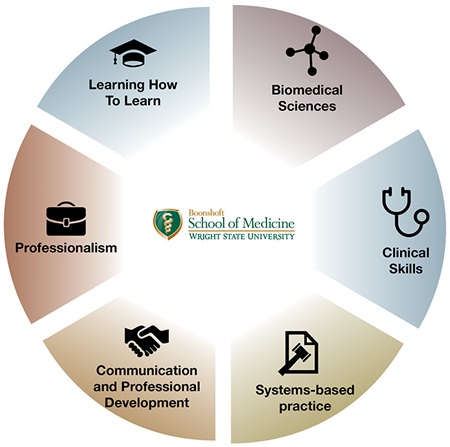On this page:
1. Medical Knowledge
Goal 1.1: Apply foundational biomedical concepts, terms, processes, and system interactions
- Objective 1.1a: Describe normal structure and function of a whole person from a cellular to an organism level
- Objective 1.1b: Identify major diseases and conditions using diagnostic methodologies
Goal 1.2: Describe the complex factors affecting and influencing health
- Objective 1.2a: Identify and describe individual and population-level biopsychosocial factors affecting and influencing health
- Objective 1.2b: Develop intervention plans that consider these complex factors
Goal 1.3: Utilize evidence-based medicine in making clinical decisions
- Objective 1.3a: Locate and utilize valid and reliable sources of clinically relevant information
- Objective 1.3b: Integrate the inherent uncertainties in the evolving state of medical knowledge
2. Clinical Skills and Patient Care
Goal 2.1: Conduct interviews and physical examinations
- Objective 2.1a: Perform comprehensive and directed history and physical exams, recognizing normal and abnormal findings
Goal 2.2: Diagnose patient health problems
- Objective 2.2a: Generate a differential diagnosis by applying medical knowledge and proposing appropriate diagnostics
Goal 2.3: Propose evidence-based health maintenance and therapeutic regimens
- Objective 2.3a: Utilize the principles of patient engagement to develop evidence-based health maintenance, diagnostic, and therapeutic regimens
Goal 2.4: Deliver effective patient presentations and document accurately in the medical record
- Objective 2.4a: Present patient history and patient findings in an organized format
- Objective 2.4b: Document patient history and patient findings in an organized format
3. Systems-Based Practice
Goal 3.1: Connect knowledge of patient populations and health delivery processes in making diagnostic and therapeutic recommendations
- Objective 3.1a: Identify and differentiate the roles of health care delivery and opportunities for clinicians to collaborate with public health and other community resources within a population health framework
Goal 3.2: Advocate for the humane, just, safe, and prudent care of persons
- Objective 3.2a: Identify contextual factors that may affect the health status of an individual patient or population
- Objective 3.2b: Demonstrate behavior that conveys compassion when interacting with diverse populations
- Objective 3.2c: Participate in patient safety and quality improvement in the clinical setting
Goal 3.3: Adapt to the complex economic social structure of health care delivery
- Objective 3.3a: Describe the legal and economic structure of the U.S. health care system and how this affects patient care
4. Personal and Interpersonal Professional Development
Goal 4.1: Reflect upon one’s personal strengths and weaknesses to make changes in one’s behavior
- Objective 4.1a: Integrate formative feedback to modify professional behavior
Goal 4.2: Find one’s own meaning in medicine
- Objective 4.2a: Include one’s personal commitment to medicine as a life of service in one’s physician mission statement
- Objective 4.2b: Form a career development plan
Goal 4.3: Take care of oneself
- Objective 4.3a: Reflect on one’s health and wellbeing as a professional responsibility
Goal 4.4: Demonstrate components of the physician's role in interprofessional collaborative practice
- Objective 4.4a: Work with team members to maintain a climate of shared values and mutual respect
- Objective 4.4b: Apply values and principles of team science to adapt one’s own role in a variety of team settings
- Objective 4.4c: Use the knowledge of one’s own role and team members’ expertise to address health outcomes
- Objective 4.4d: Communicate in a responsive, responsible, respectful, and compassionate manner with patients, families, and team members
5. Professionalism
Goal 5.1: Behave in a manner consistent with the ethical standards of the profession
- Objective 5.1a: Demonstrate the standards of individual and team-based ethical behavior
Goal 5.2: Apply knowledge of medical ethics to clinical situations
- Objective 5.2a: Demonstrate application of medical ethics in clinical decision making
Goal 5.3: Care and support others in the profession
- Objective 5.3a: Identify factors that affect the well-being of colleagues
- Objective 5.3b: Contribute to an environment of wellbeing within teams
6. Practice-Based Learning
Goal 6.1: Develop an individualized professional development plan
- Objective 6.1a: Write and regularly revise an individualized learning plan that specifies short-term and long-term SMART goals
Goal 6.2: Stimulate intellectual curiosity to question and advance knowledge through scholarship
- Objective 6.2a: Complete and present a scholarly project applying principles of ethical research
Goal 6.3: Interface with scientific evidence for one’s patient as an individual and part of a family and community
- Objective 6.3a: Locate, appraise, and utilize scientific evidence related to one’s patients’ health problems and the larger population from which they are drawn


